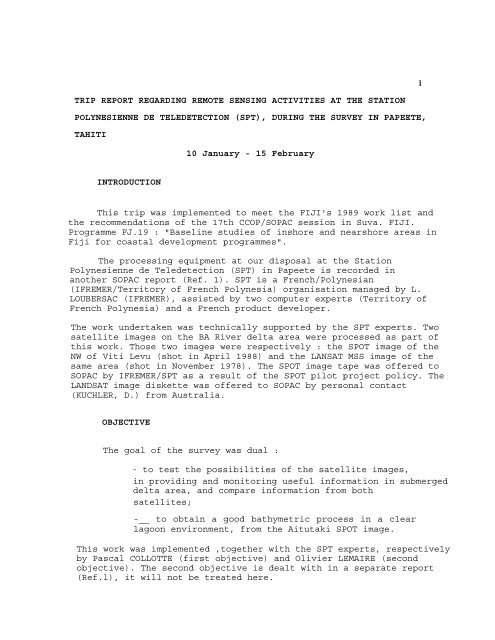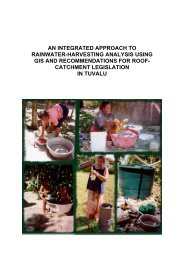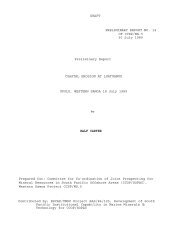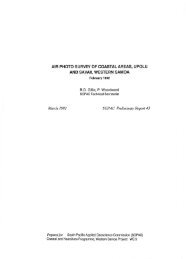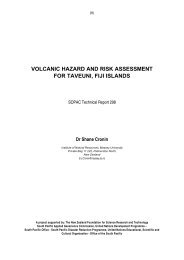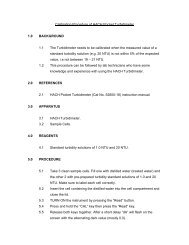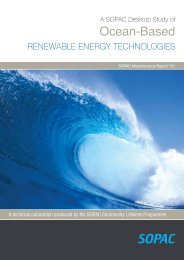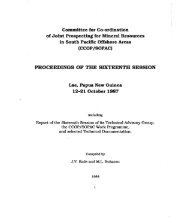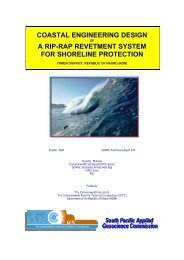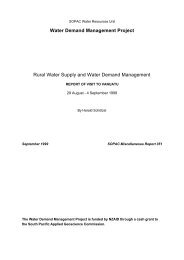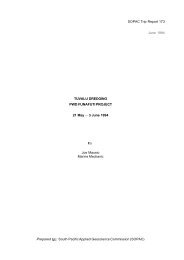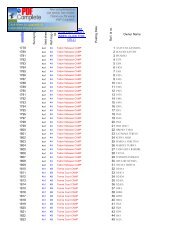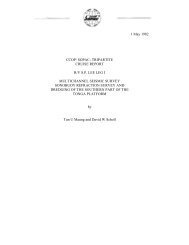Trip report regarding remote sensing activities at ... - Up To - SOPAC
Trip report regarding remote sensing activities at ... - Up To - SOPAC
Trip report regarding remote sensing activities at ... - Up To - SOPAC
Create successful ePaper yourself
Turn your PDF publications into a flip-book with our unique Google optimized e-Paper software.
TRIP REPORT REGARDING REMOTE SENSING ACTIVITIES AT THE STATION<br />
POLYNESIENNE DE TELEDETECTION (SPT), DURING THE SURVEY IN PAPEETE,<br />
TAHITI<br />
INTRODUCTION<br />
10 January - 15 February<br />
This trip was implemented to meet the FIJI's 1989 work list and<br />
the recommend<strong>at</strong>ions of the 17th CCOP/<strong>SOPAC</strong> session in Suva. FIJI.<br />
Programme FJ.19 : "Baseline studies of inshore and nearshore areas in<br />
Fiji for coastal development programmes".<br />
The processing equipment <strong>at</strong> our disposal <strong>at</strong> the St<strong>at</strong>ion<br />
Polynesienne de Teledetection (SPT) in Papeete is recorded in<br />
another <strong>SOPAC</strong> <strong>report</strong> (Ref. 1). SPT is a French/Polynesian<br />
(IFREMER/Territory of French Polynesia) organis<strong>at</strong>ion managed by L.<br />
LOUBERSAC (IFREMER), assisted by two computer experts (Territory of<br />
French Polynesia) and a French product developer.<br />
The work undertaken was technically supported by the SPT experts. Two<br />
s<strong>at</strong>ellite images on the BA River delta area were processed as part of<br />
this work. Those two images were respectively : the SPOT image of the<br />
NW of Viti Levu (shot in April 1988) and the LANSAT MSS image of the<br />
same area (shot in November 1978). The SPOT image tape was offered to<br />
<strong>SOPAC</strong> by IFREMER/SPT as a result of the SPOT pilot project policy. The<br />
LANDSAT image diskette was offered to <strong>SOPAC</strong> by personal contact<br />
(KUCHLER, D.) from Australia.<br />
OBJECTIVE<br />
The goal of the survey was dual :<br />
- to test the possibilities of the s<strong>at</strong>ellite images,<br />
in providing and monitoring useful inform<strong>at</strong>ion in submerged<br />
delta area, and compare inform<strong>at</strong>ion from both<br />
s<strong>at</strong>ellites;<br />
-__ to obtain a good b<strong>at</strong>hymetric process in a clear<br />
lagoon environment, from the Aitutaki SPOT image.<br />
This work was implemented ,together with the SPT experts, respectively<br />
by Pascal COLLOTTE (first objective) and Olivier LEMAIRE (second<br />
objective). The second objective is dealt with in a separ<strong>at</strong>e <strong>report</strong><br />
(Ref.l), it will not be tre<strong>at</strong>ed here.<br />
1
METHOD<br />
1. Study of the existing documents<br />
All mapping inform<strong>at</strong>ion relevant to the BA River area<br />
was studied, especially the following :<br />
_- the topographic map, Viti Levu, sheet 1 (1961),<br />
_- the geologic map, Viti Levu, sheet 1 (1983).<br />
_- the draft of the b<strong>at</strong>hymetric map of the Sa River<br />
Delta area (Ref. 2),<br />
_ the positive film of the SPOT image<br />
(1988),<br />
-_ the paper print of the LANDSAT MSS image (1978).<br />
For geographic incomp<strong>at</strong>ibility, the existing b<strong>at</strong>hymetric<br />
chart was not taken into account.<br />
2. Processing the raw d<strong>at</strong>a (tape)<br />
The s<strong>at</strong>ellite images are recorded on a Computer<br />
Comp<strong>at</strong>ible Tape (CCT).<br />
All processes used during the survey were obtained using the<br />
SPT in-house image processing software named GRINGO.<br />
The following method description takes the example of SPOT<br />
d<strong>at</strong>a. Three channels are taken into account to load the<br />
three SPOT channels :<br />
-_ the infra-red band (XS3),<br />
- the red band (XS2),<br />
-_ the green band (XS1).<br />
3. Decoding and extraction<br />
Decoding the CCT is done in two stages, because the control monitor<br />
can only manage a certain amount of d<strong>at</strong>a <strong>at</strong> a time. Therefore, we have<br />
to select a restricted area. The control monitor used <strong>at</strong> SPT 1s a userprogrammable<br />
image and graphic display; it is designed to off-load<br />
display and interactive processing task from a central image<br />
processing system. The maximum capability of the IVAS monitor is 1024 x<br />
1024 pixels (elementary image unit). The size of the pixel is different<br />
from one s<strong>at</strong>ellite to another. SPOT XS mode (colour) pixel size is 400<br />
sq metres and LANDSAT MSS pixel size is 4800 sq metres.<br />
In a first stage, the geometric coordin<strong>at</strong>es of the selected<br />
zone are calcul<strong>at</strong>ed from the film or print of the image.<br />
2
In a second stage, the calcul<strong>at</strong>ed zone is extracted from the CCT<br />
and loaded to the computer disk memory.<br />
This oper<strong>at</strong>ion must be done in interactive mode to control in<br />
the mean time the area being extracted. This extracted image is<br />
then loaded in three of the IVAS working channels :<br />
-_ the infra-red s<strong>at</strong>ellite band in the red channel, _<br />
- the red s<strong>at</strong>ellite band in the green channel,<br />
-_ the green s<strong>at</strong>ellite band in the blue channel.<br />
This choice permits the most realistic colours on the<br />
products.<br />
4. Image processing (see synopsis in appendix I)<br />
The following oper<strong>at</strong>ions are conducted on the area<br />
extracted off the full image (1024 x 1024 pixels).<br />
4.1 Histogrammes calcul<strong>at</strong>ion<br />
For each channel, the software allows the user to calcul<strong>at</strong>e<br />
the histogrammes (luminance versus number of pixels). This<br />
oper<strong>at</strong>ion, done in interactive mode. It permits a direct upgrade<br />
of the image on the screen by using linear functions. At this<br />
stage the image is easily readable. This allows for a pre-study<br />
of the image, giving an idea of the best type of processing to<br />
use, as well as a precise idea of the importance of the density<br />
of inform<strong>at</strong>ion in each channel.<br />
4.2 Geographic positioning of the image<br />
The existing maps are in UTM protection, <strong>at</strong> a scale of 1/50000.<br />
Then, it is important to position the image in the same grid for<br />
consistency. It is also important to do this rectific<strong>at</strong>ion <strong>at</strong><br />
this stage to avoid the geographic rectific<strong>at</strong>ion of each<br />
intermedi<strong>at</strong>e result during the processing. For SPOT d<strong>at</strong>a, it<br />
consisted mainly of a rot<strong>at</strong>ion of 6 degrees east. The image will<br />
be rectified point by point and compared to contour lines<br />
digitised from the most recent map in choosing fix-marks from<br />
it. A polygon of deform<strong>at</strong>ion is calcul<strong>at</strong>ed via the software, and<br />
applied to the image by interpol<strong>at</strong>ion from the closest neighbour<br />
pixels (Ref. 3).<br />
3
4.3 Zoning of the image<br />
While processing the image, it appeared th<strong>at</strong> 4 different<br />
zones can be defined off it :<br />
- the reef area,<br />
- the closed lagoon area covering the submerged<br />
delta,<br />
- the mangrove area,<br />
- the land area.<br />
These zones of geological interest are much different, they<br />
will be processed separ<strong>at</strong>ely. <strong>To</strong> separ<strong>at</strong>e the zones, we<br />
graphically contour them in interactive mode, using the forth<br />
IVAS channel. Then, a mask is cre<strong>at</strong>ed overlaying each zone,<br />
from which the areas are calcul<strong>at</strong>ed.<br />
5. Processing of the rectified and zoned image<br />
Each zone is processed separ<strong>at</strong>ely because of its<br />
reflectance and of its distinct geologic interest.<br />
5.1 Calcul<strong>at</strong>ion of the transfer function<br />
The choice of the m<strong>at</strong>hem<strong>at</strong>ical function depends upon the type<br />
of inform<strong>at</strong>ion we want to come up with. Therefore, we used the<br />
following functions for processing the SPOT image of the Ba<br />
River area :<br />
- a linear upgrading function applied to areas,<br />
in between limits or not, of the chosen zone;<br />
- an exponential function applied inside the limits of<br />
the histogramme peak, to upgrade preferentially the<br />
high pixel luminance classes in the lagoon zone;<br />
- a function of distribution of the pixel classes<br />
(function of their luminance), which re-divides the<br />
pixels in classes of equivalent number, called<br />
equipopul<strong>at</strong>ion distribution.<br />
More complex functions are also employed to determine<br />
different r<strong>at</strong>ings (see appendix II). The following r<strong>at</strong>ings are<br />
used to process the different zones.<br />
- chrom<strong>at</strong>ic r<strong>at</strong>ing (Ref. 4), which is use to show the<br />
turbidity of the w<strong>at</strong>er and the shallow lagoon bottom; -<br />
veget<strong>at</strong>ion r<strong>at</strong>ing (Ref. 5), for the mangrove zone;<br />
- soil shining r<strong>at</strong>ing (Ref. 5), to differenti<strong>at</strong>e bare soils<br />
in the land and wetland zones.<br />
4
5.2 Applic<strong>at</strong>ion of functions and r<strong>at</strong>ings<br />
The functions and r<strong>at</strong>ings are applied through the mask of<br />
the considered zones.<br />
5.2/1 The reef zone<br />
An equipopul<strong>at</strong>ion distribution is applied on the green and blue<br />
channels. Only a linear function is applied to the red channel,<br />
to smooth the artifact record of the wave breaking in the infrared.<br />
5.2/2 The lagoon zone<br />
A chrom<strong>at</strong>ic r<strong>at</strong>ing was applied to the entire zone. This allows<br />
for differenti<strong>at</strong>ing the delta bottom from turbid w<strong>at</strong>ers. An<br />
exponential function is applied on the submerged area of the<br />
delta. This processing produces a monochrome image, which will<br />
be loaded on each channel (R, G, B).<br />
5.2/3 The mangrove zone<br />
On this particular zone, <strong>at</strong> first a veget<strong>at</strong>ion r<strong>at</strong>ing is applied<br />
on the tidal fl<strong>at</strong>s to separ<strong>at</strong>e them from the rest of the zone.<br />
After masking veget<strong>at</strong>ion areas, an equipopul<strong>at</strong>ion distribution<br />
is applied through the mask. For a more realistic appearance, it<br />
was interesting to cross-load the red and the infra-red SPOT<br />
channels respectively in the red and the green loading channels.<br />
5.2/4 The land zone<br />
An equipopul<strong>at</strong>ion is applied allover the zone.<br />
6. Recomposition of the resulting image<br />
Once they have been processed separ<strong>at</strong>ely, the zones are<br />
brought together to recompose the resulting image.<br />
7. Compil<strong>at</strong>ion of the them<strong>at</strong>ic map<br />
The geographic grid, the culture and the legend are added<br />
to the image. Because mixing between raster inform<strong>at</strong>ion (image)<br />
and vector inform<strong>at</strong>ion (graphic) is not yet implemented, the<br />
grid and the legend are added to the image through raster<br />
transfer.<br />
7.1 Grid<br />
The grid is recalcul<strong>at</strong>ed from the topographic map of the<br />
area of interest and drawn using fix-marks.<br />
7.2 Legend<br />
The facies reference boxes are obtained in sampling windows<br />
from the concerned zones of the image. The loc<strong>at</strong>ion of boxes and<br />
text is calcul<strong>at</strong>ed on the legend sheet before positioning.<br />
5
RESULTS<br />
Three maps were produced <strong>at</strong> the scale of 1/50000, : -<br />
the Ba River Them<strong>at</strong>ic Map (Viti Levu, FIJI), using the<br />
SPOT image (April 1988);<br />
_- the Ba River Them<strong>at</strong>ic Map, using LANDSAT MSS d<strong>at</strong>a<br />
(November 1978); the same processing as SPOT d<strong>at</strong>a<br />
processing was applied to allow for a comparison of the<br />
maps to monitor the changes within 10 years time;<br />
-_ the comparison map between SPOT d<strong>at</strong>a and LANDSAT d<strong>at</strong>a in<br />
the submerged part of the Ba River Delta.<br />
Four zones are identified :<br />
- the reef zone,<br />
- the submerged river delta zone,<br />
- the mangrove zone,<br />
- the land area.<br />
Various types of facies have been identified in each zones,<br />
using only s<strong>at</strong>ellite inform<strong>at</strong>ion.<br />
In the lagoon:<br />
- a partition reef facies,<br />
- two types of shallow marine reef,<br />
- pinnacles,<br />
- emerged surficial coral sands,<br />
- submerged deltaic deposits.<br />
In the wetland zone:<br />
- tidal fl<strong>at</strong> bare soils,<br />
- a bushy type of mangrove,<br />
- a shrubby type of mangrove.<br />
Inland:<br />
- the forest areas,<br />
- a "bush" facies<br />
- the inland bare soils,<br />
- the sugar cane fields.<br />
6
CONCLUSION<br />
These three s<strong>at</strong>ellite products being geographically<br />
rectified and reduced to a comp<strong>at</strong>ible scale, they are able to<br />
be used with usual map form<strong>at</strong>.<br />
On the southern part of the Tavutha reef, a shrubby type of<br />
mangrove growing on coral sand deposits is recognised.<br />
The submerged delta appears very well as well as the main<br />
channels of river and creeks and their distributaries.<br />
Two types of mangroves are identified, one is pioneer (bushy<br />
mangrove), the other one <strong>at</strong>tests of an evolution. The tidal<br />
fl<strong>at</strong>s are also identified.<br />
The comparison between SPOT and LANDSAT MSS d<strong>at</strong>a shows the<br />
evolution of the shrubby mangrove on the east part of the<br />
wetland zone. But no big difference appears in the submerged<br />
delta zone in 10 years time.<br />
In the land area the bare soils appear very well, especially the<br />
basins of the Ravi-ravi prawn farm. The forest areas and sugar<br />
cane fields are also easily mappable<br />
7
APPENDIX II<br />
The following r<strong>at</strong>ing, have been used to process the<br />
s<strong>at</strong>ellite images of the Ba River Delta area. They are based on<br />
equ<strong>at</strong>ions involving the wave length bands scanned by the<br />
s<strong>at</strong>ellite sensors.<br />
BANDS! SPOT ! LANDSAT"<br />
! !<br />
Green band! XS1 = 500/590 nm ! BAND 5 = 500/600 nm<br />
Red band! XS2 = 610/ 690 nm! BAND 6 = 600/700 nm<br />
I.R band! XS3 = 700/890 nm ! BAND 7 = 700/800 nm<br />
1. CHROMATIC RATING<br />
This algorithm is upgrading sediment inform<strong>at</strong>ion in shallow<br />
w<strong>at</strong>er.<br />
If A and B are the peak limits of the histogrammes of the 3<br />
bands, the chrom<strong>at</strong>ic r<strong>at</strong>ing is equal to : rXS2/XS1+XS21,<br />
between A, B.<br />
2. VEGETATION RATING<br />
This algorithm makes it easier to differenti<strong>at</strong>e the<br />
veget<strong>at</strong>ion from the bare soils. It is equal to : rXS3-<br />
XS2/XS3+XS21
APPENDIXES
REFERENCE<br />
Ref. 1: LEMAIRE, O.<br />
Report on the Aitutaki processing <strong>at</strong> the St<strong>at</strong>ion<br />
Polynesienne de Teledetection, Tahiti. 10 January - 8<br />
February 1989.<br />
CCOP/<strong>SOPAC</strong> trip <strong>report</strong> (pending)<br />
Ref. 2: GRINGO version 2, manuel utilis<strong>at</strong>eur<br />
Rapport interne IFREMER, 1987.<br />
Ref. 3: LOUBERSAC, L.<br />
Coastal zones inventory by high resolution s<strong>at</strong>ellites. Remote<br />
<strong>sensing</strong> Processing Alpbach Summer School, ESA SP-205, pp 87-94.<br />
Ref. 4: JUPP, D.L.B., HEGGEN, S.J., MAYO, K.K., KENDALL, S.W.,<br />
BOLTON, J.R., and HARRISON,B.A.<br />
The BRIAN hand book : an introduction to LANDSAT and BRIAN<br />
system for users.<br />
CSIRO Division of W<strong>at</strong>er and Land Resources, N<strong>at</strong>ural<br />
Resources, Series N.3, 1985<br />
Ref. 5: LOUBERSAC, L. and POPULUS, J.<br />
The applic<strong>at</strong>ion of high resolution s<strong>at</strong>ellite d<strong>at</strong>a for coastal<br />
management and planning in a Pacific coral island. Geocarto<br />
Intern<strong>at</strong>ional Vol.2, pp 17-31, 1986.


